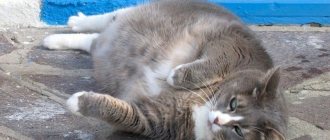False pregnancy occurs in all mammals, including humans. It happens much more often in dogs, but cat owners can also encounter this. Not so long ago, no treatment was carried out in a similar situation - the owners simply limited the animal’s food and distracted it, not allowing it to “build a nest.” Now doctors prescribe hormonal and sedative drugs to neutralize the effects on physiological processes.
What is a false pregnancy in cats?
Many cat lovers think that this phenomenon in cats is a fairy tale, because it does not occur often. So do cats actually have false pregnancies? Indeed, cats encounter it less often than dogs, since dogs in nature live in a pack. If something happens to the mother, the puppies will be fed by another pseudo-pregnant female, who has not given birth to children, but milk production is quite real.
In cats, which usually do not care about other people's offspring, this occurs as a pathological process. In a psychoneurotic state, Murka thinks she is pregnant, but you can’t count on the appearance of offspring. If a false pregnancy is observed in a cat, the symptoms of which are clearly manifested, it is better to make an appointment with a specialist in order to stop the condition and minimize unpleasant consequences.
In general, pseudo-pregnancy looks like real pregnancy with kittens: the belly enlarges, the nipples swell, and the cat expects birth. But the kittens will not appear, and this will not have the best effect on the cat.
How long does it last
The usual condition lasts about three weeks, but sometimes it lasts up to several months. How everything will proceed depends on the individual characteristics of the animal: age, temperament, health, psychological state. The longer the cat is in the “position”, the worse and more dangerous the situation and the more serious medical assistance the pet requires.
How to distinguish from the real one
If a hormonal disorder occurs without the participation of a cat or with the participation of a recently castrated male, then it is not difficult to guess that the cat has a false pregnancy. What to do if it is not clear whether mating took place? How to determine whether a cat will give birth or not? A false positive pregnancy differs mainly from a psychological point of view in the first three weeks:
- A really pregnant pet often experiences sudden changes in mood: she can be affectionate, and a second later she can get angry and attack. This happens very rarely with pseudopregnancy.
- If the female really becomes pregnant, then she nests for childbirth a few days before the event, and otherwise she looks for a place from the onset of the first symptoms. She can rummage through closets all day long and arrange the most inaccessible corners of her home.
- The postpartum behavior of an animal before birth is a clear sign of the imagination of future motherhood. She can “adopt” a slipper or a soft toy and carry this thing in her teeth throughout the house.
At two weeks, pregnancy is already determined by ultrasound, and at three, by a relaxin test, which requires blood plasma. Therefore, if in doubt, take your cat for examination to a veterinarian - he will definitely tell you whether there will be kittens in your family.
Predisposition by breed
False pregnancy can occur in absolutely any cat, but there is also a breed predisposition. Statistics show that among sphinxes, rexes and oriental breeds, every seventh individual, or about 15% of females, suffers from this hormonal disorder. Moreover, this feature is hereditary. Often the breeder prefers to sterilize the animal and not use it for breeding if false pregnancy has occurred more than two times in a row. In this case, there is a high probability that the offspring will be weak and non-viable even with a successful mating.
False pregnancy - what is it?
Pseudopregnancy is a condition of a female in which all the signs of a normal pregnancy appear. It is primarily due to hormonal and/or mental disorders. Can be inherited.
False pregnancy usually occurs immediately after estrus, even if the cat does not go outside and does not come into contact with other animals. The behavior of a female cannot be truly distinguished from that of a pregnant woman, but the kittens will not appear, and the process itself will greatly harm the pet. The duration of the condition rarely lasts more than 1-1.5 months. It appears 6-12 weeks after the start of estrus. At particular risk are: Orientals, Sphynxes, Cornish Rexes.
Will sterilization help?
False pregnancy can also occur in sterilized cats. Moreover, if an imaginary pregnancy occurred only once, and in the future you plan for your cat to have kittens, then sterilization is definitely not necessary. You only need diagnostics a couple of times a year and that will be enough.
- If pseudopregnancy is a constant phenomenon, and you do not plan to have kittens, then it is still better to carry out sterilization.
- But it will be very important to re-examine after surgery to make sure that all ovarian tissue was removed.
- This is necessary to ensure that a false pregnancy does not recur.
Be attentive and affectionate to your pet during this period. It is important that she is not left alone. And with proper treatment, the problem will go away faster.
Causes
The occurrence of false pregnancy in cats is influenced by 2 factors:
- psychological;
- physiological.
Psychological reasons
- Mating with a neutered or sick cat
“Empty” mating causes the cat to release hormones - prolactin and estrogen, and the level of progesterone, on the contrary, decreases. The body adjusts to pregnancy, external and internal processes are activated, but fertilization does not occur.
- Mating at the end of the cycle (estrus)
In this case, the corpus luteum may remain, which will provoke all the symptoms of false pregnancy in the cat.
- Neighborhood with pregnant females
When there are cats in the house giving birth, another one can watch her and then repeat the behavior. Deviations begin in the psyche, which affects the general condition of the animal.
- Severe stress
The causes of stress can be: moving, long separation from the owner, previous operations, etc. The animal can compensate for all these situations with an imaginary pregnancy.
Physiological reasons
- Hormonal disbalance
It often happens in old cats, as well as due to diseases of the endocrine system (diabetes mellitus, obesity, etc.).
- Congenital pathology of the reproductive organs
These include inflammatory processes of the uterus, polycystic ovary syndrome, endometritis, fibroids and other diseases of the reproductive system.
- Genetic predisposition
If an animal has inherited this pathology, it is recommended to carry out sterilization in the early stages.
- Thyroid diseases, etc.
Remember that only a veterinarian can accurately determine the cause and prescribe the correct treatment.
Is false pregnancy possible in cats after sterilization?
Neutering a cat is an operation to remove the ovaries. It makes life much easier for a cat whose pregnancy is not planned. Firstly, the risk of many reproductive and cancer diseases is eliminated.
Secondly, the female’s estrus stops, so a false pregnancy after sterilization in a cat is 100% excluded.
Other benefits include:
- change in character for the better - the animal becomes calmer, attacks of aggression disappear;
- the animal stops marking territory in the apartment;
- during the process of estrus she does not suffer if mating with her partner does not occur.
In order to completely protect your pet, it is better to sterilize it at 5-7 months, before the onset of puberty. In this case, the cat will undergo the operation more easily and the recovery period will pass quickly.
Sterilization and its connection with false pregnancy
Sterilization, that is, removal of the uterus and ovaries, is a radical way to combat false pregnancy. The necessary hormones are not produced, and the condition becomes impossible, so frequently recurring similar hormonal disorders are a clear indication for sterilization. If the individual is a breeder, it is not at all necessary to sterilize it after the first unsuccessful mating; first you need to try to find out the cause of the problem. Perhaps, after a change of partner or after treatment, the pet will be able to have offspring, and the disease will not recur.
Surgery is recommended if the owner does not intend to breed the pet - after sterilization, the pet will be free from diseases of the reproductive system in the future, and, perhaps, will live several more years of life.
Signs
How can you tell if your cat is experiencing symptoms of a fake pregnancy? You can diagnose the pathology yourself using the following changes in behavior:
- sudden changes in mood (attacks of tenderness to aggression or vice versa);
- exacerbation of the maternal instinct (the female begins to arrange a separate corner for the future “offspring”, carries her toys in her teeth, licks them);
- swollen nipples;
- mucous discharge from the vulva;
- digestive problems (vomiting, stool disorders);
- temperature increase;
- brutal appetite (during normal pregnancy it worsens);
- severe bloating;
- general increase in body weight;
- drowsiness;
- apathy towards familiar games.
If you notice any of these signs in your pet, then immediately seek help from a specialist. The “Svoy Doctor” network of veterinary clinics will help to promptly identify signs of false pregnancy in cats and prescribe treatment.
SVK “Svoy Doctor” provides a wide range of services:
- sterilization (laparoscopic, chemical);
- cryodestruction (surgical removal of tumors with liquid nitrogen);
- reproductology;
- ultrasonography;
- observation of an animal in a hospital, etc.
The clinic is open 24 hours a day. To make an appointment, you can first send a request on the website - an operator will call you back to clarify the information. It is possible to call a doctor to your home to avoid the animal’s stress.
Symptoms
With a false pregnancy, the following pathological symptoms develop:
- Behavioral: lethargy, drowsiness, irritability. Before an imaginary birth, the cat becomes sociable or, conversely, aloof. It begins to nest, that is, scurry around in search of a den. Prefers the inside of cabinets. Postpartum behavior involves searching for young. The female mistakes soft toys for kittens and begins dragging them from one place to another.
- Physiological: vaginal discharge appears, which the cat carefully licks. The belly enlarges, the nipples swell, and milk is produced. The pet becomes voracious, then digestive disorders begin. The cat refuses to eat. Mastitis and genital pathologies develop.
Most often, refusal to eat, as well as lack of stimulation of the mammary glands, leads to cessation of lactation and recovery. If this is not the case, the problem is solved with the help of a specialist.
Complications and possible consequences
Medical care is provided to the animal only in case of complications or other diseases. Their risk increases if the owner does not promptly contact the clinic for a complete examination of the cat. Females are especially at risk, as this is not the first time this pathology has appeared.
Possible consequences include:
- Malignant neoplasms
- Pyometra and endometritis
Pyometra is an inflammation of the uterus in females, accompanied by the accumulation of purulent, mucous contents mixed with blood inside the cavity. The radical and most reliable method of treatment is surgical – ovariohysterectomy (the ovaries and uterus are removed).
The most obvious symptom of open pyometra is foul-smelling vaginal discharge. They can be abundant or scanty, but almost always appear 1-1.5 months after the end of the last estrus.
The closed form is insidious in that there are no secretions. At the same time, the owner often does not notice that the animal has become less active, is eating poorly, and its belly is slightly sagging and enlarged.
Endometritis is an inflammation of the lining of the uterus. Most often diagnosed in older or unsterilized cats aged 1 to 7 years.
In the chronic form of the disease, the animal looks healthy outwardly, but licks itself more often in the vulva area, the level of activity and appetite decreases, and the temperature rises. In the early stages, it is possible to use conservative treatment with antibiotics and antimicrobials; in advanced stages, only sterilization, since worsening the situation will lead to the development of peritonitis.
- Mastitis
Mastitis is an inflammation of the mammary glands. The lactation process starts, but the milk does not go anywhere. This leads to infectious-inflammatory, purulent formation. The nipples crack and hurt, unusual discharge appears, general health worsens and weight loss begins.
Serous mastitis at the initial stage can be easily treated with antibiotics, but abscess mastitis is much more difficult and longer and may require surgical intervention.
- Infertility
Such disturbances in cycles 2 and 3, as well as repeated cases of false pregnancy, can deprive the cat of the opportunity to bear offspring.
- Severe mental state and long-term depression
During actual pregnancy and after it, females can experience severe emotional stress. When kittens are born, they actively protect them and do not let humans get close. They may behave aggressively, hissing, biting or scratching.
When an animal imitates the process of motherhood, then various objects in the house, not just toys, turn out to be kittens. Females turn all their attention to them. Attempts to take away these objects or interfere with the “caring mother” can lead her into a state of deep depression. The cat will not be able to cope with this on its own.
In these cases, the veterinarian must rule out these diseases, frozen pregnancy, and return the general condition (physical and emotional) to normal.
Why is pathology dangerous?
So why is imaginary pregnancy dangerous in cats? To many:
- Since these pets often develop it for a reason, but against the background of quite serious hormonal disorders or pathologies of the reproductive system, with special “luck” it can lead to oncology.
- It has been noticed that cats that have had an “empty” pregnancy two or more times in a row are subsequently practically useless from the point of view of reproduction. They either become worse pregnant, or their offspring are weak and nonviable.
- The likelihood of pyometra, chronic endometritis and ovarianitis (inflammation of the uterus and ovaries, respectively) increases.
Mastitis during false pregnancy
But still, more often than not, cat owners face another problem. Mastitis during false pregnancy occurs very often. The problem is that cats themselves are extremely difficult to tolerate inflammation of the mammary glands; the risk of death is quite high.
The mechanism of mastitis development in this case is very simple:
- Since during a false pregnancy milk secretion occurs regularly, but there is no one to suck it out, the liquid constantly accumulates in the alveoli and milk ducts.
- Gradually, the pressure becomes such that the milk flows by gravity (sometimes with force, as if from a spray bottle) out of the nipples.
- If these streaks are not removed in time and the skin is not wiped, the milk turns sour, creating excellent conditions for the development of pathogenic and conditionally pathogenic microflora. Gradually, the microbes will penetrate into the mammary gland itself and cause inflammation there.
With this pathology, the nipples and adjacent tissues become very hard, and local and general body temperature rises. The slightest touch to the nipples results in inappropriate behavior of the animal, to which palpation causes unbearable pain.
Important! Treatment in a clinical setting is urgently required, as otherwise the cat could easily die.
In particular, with the slightest delay, inflammation easily turns into a purulent form, when thick, yellow-green pus begins to secrete from the nipples. The probability of successful treatment is 50/50 (in other words, depending on your luck). In addition, in advanced cases, sterilization is almost always required.
Treatment of false pregnancy in cats
If the case is advanced and the symptoms of a false pregnancy in a cat are accompanied by other complications, then a full examination is required.
First you need to take all the tests (smears, blood tests for hormones) and do an ultrasound. Ultrasound diagnostics will help to exclude diseases of the reproductive system and other complications. Next, the doctor will prescribe a course of therapy depending on the pathologies found: surgery, chemotherapy, cryodisruption, etc.
Additionally:
- a course of antibiotics, sedatives or hormonal drugs is prescribed;
- special agents are introduced that stop lactation.
At an early stage of diagnosis, pathology can be eliminated by adjusting the animal’s behavior and nutrition. To do this, you need to perform the following algorithm of actions:
- Reduce caloric intake and reduce portions.
- Follow a diet, exclude fermented milk products (it is better to switch to dry food).
- Do not punish the animal for pranks, play more often and pay more attention to it.
- Remove soft toys that provoke maternal instinct.
- It is advisable to protect the cat from contact with others.
Remember that the appearance of signs of false pregnancy in cats requires a mandatory examination at a veterinary clinic. Do not self-medicate under any circumstances and do not hope that the symptoms will go away on their own. The process of treating an animal is strictly individual. Constant medical supervision and long-term therapy may be required.
What is proestrus, estrus, diestrus?
The first phase of the cycle is proestrus
Usually this period is called “estrus”. It manifests itself as swelling of the vulva and bloody vaginal discharge. A bitch on a walk urinates often and little by little - as if “leaving traces” by which a male can find her. During this period, the bitch is very attractive to males, flirts with them, but does not allow them to mount and reacts aggressively to these attempts.
It is a common misconception that this period and spotting are the same as menstruation in women. However, this is absolutely false: in bitches the blood comes from the walls of the vagina, and not from the uterus, as is the case with menstrual bleeding. And in women, these signs are a sign of the end of the cycle, and in bitches, on the contrary, they are just beginning.
The second phase of the cycle is estrus.
It manifests itself as a change in the color of vaginal discharge: from bloody to pink or straw-colored. At this time, the bitch allows the male to mount and mate. During estrus, eggs mature in the ovaries. When ovulation occurs, they “come out” and the bitch becomes fertile.
The third phase is diestrus.
In place of the burst follicles from which the eggs were released, yellow bodies appear. They produce progesterone, the pregnancy hormone.
If the bitch is pregnant, then other hormones are activated to help maintain the corpus luteum and the desired level of progesterone throughout the 60-63 days of pregnancy.
If the bitch is not pregnant, the corpus luteum gradually depletes and the body returns to its normal state. In dogs, unlike most animals, this condition lasts as long as pregnancy (60-70 days). This means that the corpus luteum functions for approximately 60-70 days - the same in pregnant and non-pregnant bitches! At the same time, the same hormones are released and in almost the same quantities. This explains it all - the hormones are present, but there are no puppies. That's why many scientists say that false pregnancy always exists, since it is a normal part of the cycle, but its manifestations can be different: from very pronounced to almost invisible.
Clinical manifestations of false pregnancy in dogs.
Clinical symptoms of false pregnancy vary greatly: they can be mild or blurred, not even noticed by the owners, or they can reach serious changes, such as: loss of appetite, toxicosis, morning vomiting, fever, abdominal enlargement, swelling of the mammary glands, in which milk or thick transparent mucous secretion. There may be a small amount of vaginal discharge, and the loop may be enlarged, swollen, or edematous. Anxiety and irritability almost always increase. The bitch “can’t find a place for herself,” whines and rushes about. Sometimes there are even false births, accompanied by painful contractions.
The appearance of milk during false pregnancy
A strong desire appears to “build a nest” into which she can bring “puppies”. At the same time, she can redirect the maternal instinct not only to toys and any other inanimate objects, but also to other animals, and even humans! In these cases, the bitch is unusually affectionate, follows on the heels, strives to lick, groom, can bring food, show simply terrible jealousy and “protect” from other members of the “pack.” The bitch may begin to take care of another member of the “pack” - a cat, another dog, guinea pig, etc., often causing sincere bewilderment (see photo).
There are cases when bitches fed KITTENS, sometimes with the full consent of the mother cat. If there is another bitch in the house with puppies, then both can feed. True, sometimes rivalry can arise, and the “pseudo mother” can enter into a real fight for the puppies that she considers her own. If this happens in fighting breed dogs, there can even be deaths.
Even if the symptoms of false pregnancy are not pronounced, measures should still be taken to alleviate the dog’s condition.
False pupishness, caring for toys
TREATMENT OF FALSE PREGNANCY.
If the symptoms of this condition are mild, they will go away on their own without medication after 3 weeks. During this period, you need to slightly reduce the dose of food and water.
— If the feeding is natural, then you should reduce the amount of protein foods in the diet: a minimum of meat and generally exclude dairy products;
- if you feed dry food, then switch to “Light” - the protein content is lower;
- reduce the amount of water - moderate dehydration of the body will stop milk production.
- increase physical activity.
Under no circumstances should you express milk or tighten the mammary glands.
If the bitch sucks milk herself, this is bad, as it helps to increase its quantity. You should wear a blanket or wipe the nipples with camphor oil - its pungent smell will scare the dog away. In addition, camphor preparations suppress lactation.
Attention! Sometimes an allergy may occur to camphor compresses and ointment - local skin irritation. In this case, it is better to dilute camphor alcohol with water to soften the effect on the skin, and rub the ointment with light movements and in no case press or massage too much. If irritation does not go away, stop use and consult a veterinarian.
To combat inflammation of the mammary glands, folk remedies are often used: compresses made from black bread crumb mixed with honey, rubbing swollen areas with aloe juice. One of the most effective methods is considered to be a cabbage leaf: it is scalded with boiling water, kneaded a little with your hands, and fine frequent cuts are made with a knife to release the juice. The oozing juice is applied to the mammary glands, tied or put on a blanket. It can last all night.
Also, for severe hardening, you can use homeopathic arnica ointment in the morning and evening.
Prevention
Special preventive measures will help prevent pseudopregnancy in cats in advance. These include the following rules:
- The most reliable way is mandatory sterilization at a young age.
- If the animal will give birth, it is recommended to carry out mating after the 3rd heat.
- If there are several cats in the apartment at once, then it is better to temporarily place the pregnant woman in a separate room.
- Mate only with healthy cats that have already given birth to healthy offspring.
- If your cat does not become pregnant after several matings, contact a reproductive specialist.
- Maintain proper diet;
- Relieve the animal from stress.
Carefully monitor your cat's health to avoid treating false pregnancy and protect it from complications.










